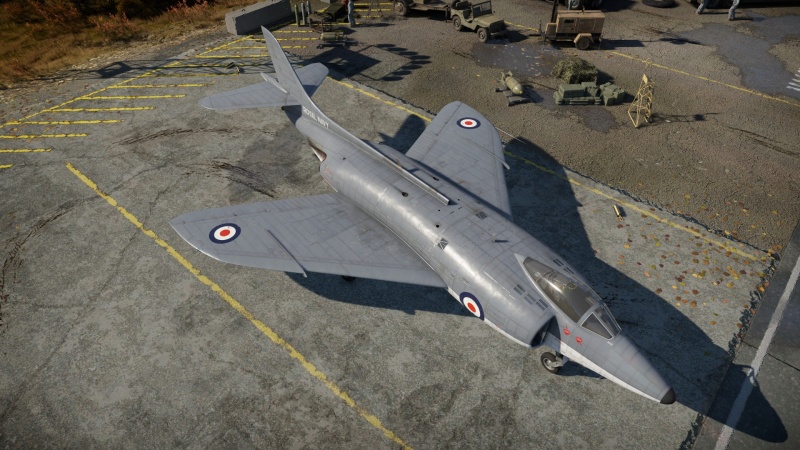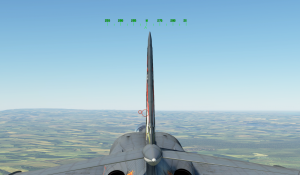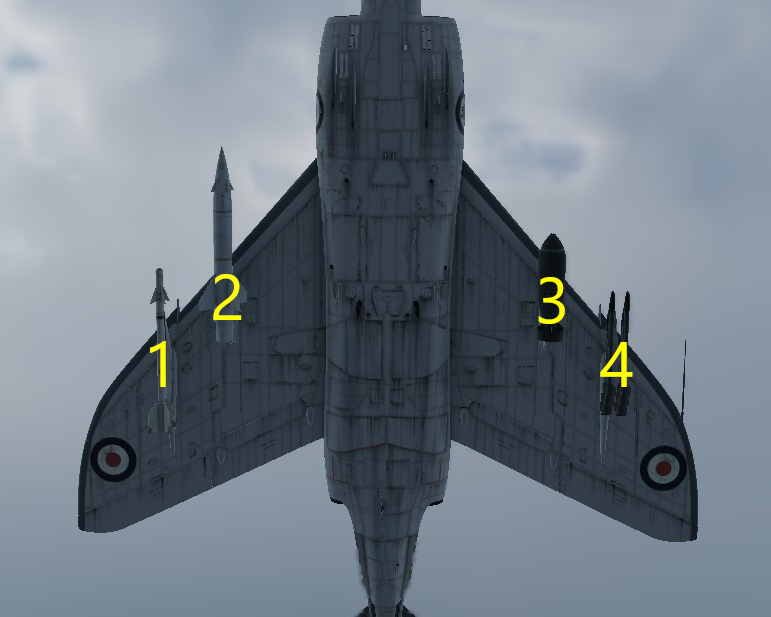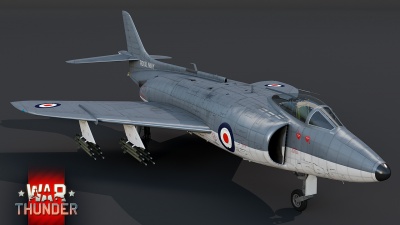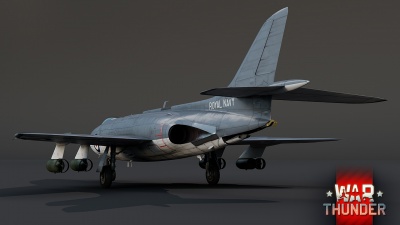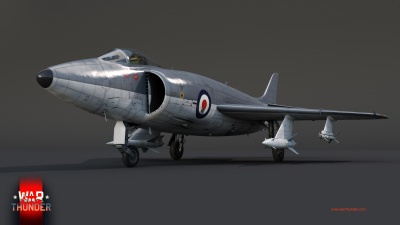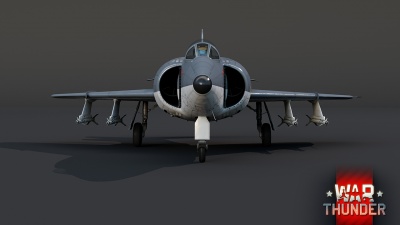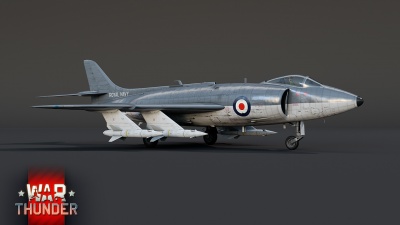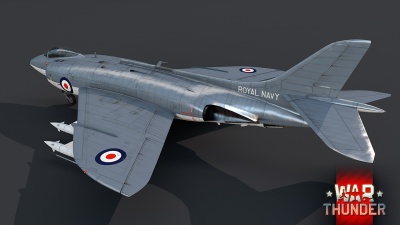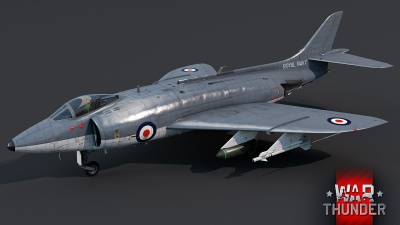Scimitar F Mk.1
Contents
Description
The last aircraft ever produced by the famous Supermarine company, the Scimitar was developed to meet the Royal Navy's requirements for an aircraft with good low-altitude manoeuvrability and wide choice of strike ordnance. Featuring two large Rolls Royce Avon Mk.202 engines, the Scimitar was the heaviest and most powerful aircraft to have been in service with the Fleet Air Arm at its entry in 1958. While the plane was generally praised for its low-level and low-speed flight characteristics, helped in part by a special flap-blowing system that allowed some of the excess thrust to be redirected across the flaps to reduce its stall speed, over half of the 76 Scimitars produced were lost to accidents, and the plane had generally poor reliability and serviceability. The aircraft was quickly relegated to second line duties with the introduction of the Blackburn Buccaneer in 1962, and was finally retired completely in 1970.
Introduced in Update "Starfighters", the Scimitar is a heavy but very powerful carrier-borne fighter. Its two immensely powerful engines make it one of the fastest subsonic aircraft in the game and afford it great acceleration and climb rate, however its interesting handling characteristics can make it an particular challenge to fly. Notably, while the pitch and roll capabilities are generally sufficient, especially for such a large aircraft, the poor rudder response at high speed can make the four powerful ADEN cannons (difficult to handle at the best of times) extremely impractical to aim. However, this limitation can be mitigated by sensible approach planning, and by making proper use of the four AIM-9B Sidewinder missiles also able to be equipped. As well as being a powerful fighter, the Scimitar has excellent ground attack capability, and is the first British aircraft (second being the Buccaneer) capable of carrying air-to-ground missiles.
General info
Flight performance
The Scimitar F.1 is a relatively large and heavy aircraft, but it is still extremely capable because of its impressive engines. The Scimitar's two Rolls-Royce Avon 202 engines put out 4,650 kgf of thrust each, giving the Scimitar its fantastic climb rate of over 100 m/s. This outclasses similarly placed jets known for their climb rate (such as the MiG-15) by almost 2 times, and it's capable of gaining speed in a 45° climb. The impressive amount of power means that, assuming you aren't uptiered to 9.7, you will always be the first off the airfield and into combat. The Scimitar has a max speed of just over 1,160 km/h or mach 0.95 on the deck, enough to outrun anything at its BR, and even some missiles too. In an uptier, there are many planes faster than you so be extra cautious: don't engage first and look for an opportunity.
The Scimitar has very poor manoeuvrability due to its large weight and size, the yaw controls are particularly bad. It is therefore recommended that you only engage low energy targets and use the element of surprise so they cannot evade. If the target is aware of your presence, they will easily evade you. Unlike other jets at its BR, the Scimitar also struggles to dodge missiles. You should make sure that no one is in a position to be on your six since once an enemy is behind you and gaining on you, there is nothing you can do. The Scimitar does get 4 x AIM-9B missiles, and these can be used on targets that use your lack of a rudder against you, however you should keep in mind that they are only 10G missiles and can easily be dodged by the enemy. Overall this aircraft seems good on paper, however its poor handling plays hugely against it.
| Characteristics | Max Speed (km/h at 0 m - sea level) |
Max altitude (metres) |
Turn time (seconds) |
Rate of climb (metres/second) |
Take-off run (metres) | |||
|---|---|---|---|---|---|---|---|---|
| AB | RB | AB | RB | AB | RB | |||
| Stock | 1,156 | 1,152 | 15200 | 31.4 | 32.2 | 84.3 | 78.3 | 1,000 |
| Upgraded | 1,170 | 1,163 | 29.4 | 30.0 | 122.4 | 102.0 | ||
Details
| Features | |||||
|---|---|---|---|---|---|
| Combat flaps | Take-off flaps | Landing flaps | Air brakes | Arrestor gear | Drogue chute |
| ✓ | ✓ | ✓ | ✓ | ✓ | X |
| Limits | ||||||
|---|---|---|---|---|---|---|
| Wings (km/h) | Gear (km/h) | Flaps (km/h) | Max Static G | |||
| Combat | Take-off | Landing | + | - | ||
| 1322 | 583.3 | 603 | 532 | 447 | ~11 | ~3 |
| Optimal velocities (km/h) | |||
|---|---|---|---|
| Ailerons | Rudder | Elevators | Radiator |
| < 620 | < 500 | < 620 | N/A |
Engine performance
| Engine | Aircraft mass | |||||
|---|---|---|---|---|---|---|
| Engine name | Number | Empty mass | Wing loading (full fuel) | |||
| Rolls-Royce Avon Mk.202 | 2 | 11,722 kg | 349 kg/m2 | |||
| Engine characteristics | Mass with fuel (no weapons load) | Max Takeoff Weight | ||||
| Weight (each) | Type | 6m fuel | 20m fuel | 22m fuel | ||
| 1,175 kg | Axial-flow turbojet | 12,817 kg | 15,341 kg | 15,702 kg | 19,731 kg | |
| Maximum engine thrust @ 0 m (RB / SB) | Thrust to weight ratio @ 0 m (100%) | |||||
| Condition | 100% | WEP | 6m fuel | 20m fuel | 22m fuel | MTOW |
| Stationary | 4,652 kgf | N/A | 0.73 | 0.61 | 0.59 | 0.47 |
| Optimal | 4,855 kgf (1,100 km/h) |
N/A | 0.76 | 0.63 | 0.62 | 0.49 |
Survivability and armour
The Scimitar has one glass 50 mm plate in front of the pilot, and one 12.7 mm steel plate behind the pilot. It has very low survivability because any wing damage will lead to a flatspin, due to its lack of rudder control.
Modifications and economy
The poor rudder of the Scimitar makes getting two modifications a high priority. The New boosters modification provides a noticeable improvement to the rudder control of the Scimitar and is your absolute top priority, as any rudder improvement you can get will make getting guns on target, and flying the aircraft in general, more bearable. Even with the New boosters modification getting guns on target can still be rather hard; therefore the next priority is AIM-9B missiles as they give you another way to kill enemy aircraft, which is less reliant on rudder control. Even stock the Scimitar exhibits very impressive flight performance for its battle rating, this means flight performance upgrades (with the exception of New boosters) are not as important as on other jets. Starting at tier 1, you will want to unlock the rockets (to start progressing towards AIM-9Bs), then at tier 2 unlock the New boosters modification and then the bombs. At tier three do your choice of flight performance modification followed by the Bullpups (unless you want the Bullpups for Tank RB, in which case get them first); finally get the AIM-9Bs at tier 4. From here on you can unlock the remaining modifications according to user preference.
If you find unlocking modifications difficult due to the lack of rudder control then the stock ADEN belts are capable of killing light pillboxes/light tanks (and medium tanks with some more difficulty), allowing you to get a decent amount of RP per game through ground attack. The suspended armaments can also be used for ground attack or base bombing.
Armaments
Offensive armament
The Scimitar F Mk.1 is armed with:
- 4 x 30 mm ADEN cannons, chin-mounted (160 rpg = 640 total)
Suspended armament
The Scimitar F Mk.1 can be outfitted with the following ordnance:
| 1 | 2 | 3 | 4 | ||
|---|---|---|---|---|---|
| 1,000 lb M.C. Mk.I bombs | 1 | 1 | 1 | 1 | |
| AP Mk II rockets | 6 | 6 | 6 | 6 | |
| AGM-12B Bullpup missiles | 1 | 1 | 1 | 1 | |
| AIM-9B Sidewinder missiles | 1 | 1 | 1 | 1 | |
| Maximum permissible weight imbalance: 850 kg | |||||
| Default weapon presets | |
|---|---|
| |
Usage in battles
Thanks to its very powerful engines (it has a higher total thrust output than many supersonic aircraft), the Scimitar possesses an exception rate of climb and top speed for its BR, being easily one of, if not the fastest subsonic aircraft in the game. You should use this to your advantage when playing the Scimitar. At the start of the game you can choose to either go high or go low.
If you choose to go high then you should use your rate of climb to get above the enemy and either pick off bombers (your missiles can help greatly with this) or position yourself ready to dive down on enemy players, many of whom will still be climbing. Going low is the riskier option and relies on the Scimitar's immense speed for your survival. You should stick below 2,000 m altitude and work your way towards the edge of the battle, then turn into the fight and choose targets to attack, making a single pass before using your speed to escape. You should keep your speed up at all times and regularly check your tail for aircraft and missiles. While you can easily out run just about all subsonic aircraft, supersonic aircraft can cause you problems. Likewise you can outrun missiles launched at longer ranges, but not those launched close to you.
Whichever playstyle you choose, the Scimitar will offer you a powerful armament of 4 ADEN cannons, with a plentiful supply of ammunition. You also have access to 4 AIM-9B missiles. While the AIM-9B is nothing special compared to other missiles (being about average for this BR range) it can be very useful once you learn how to use them. In particular, they make taking out bombers much easier. The Scimitar is also a very capable CAS platform with powerful cannons (can kill light pillboxes and medium tanks in Air RB, and penetrate the tops of some tanks in ground RB), and an assortment of ground attack load-outs. Notably it is the first British aircraft to get access to air-to-ground missiles, in the form of the AGM-12B Bullpup.
Despite these advantages the Scimitar does have some major drawbacks, mainly related to manoeuvrability. While it can turn better than you would expect for an aircraft of its weight, it is by no means a nimble aircraft and should not be treated like one; prolonged turning engagements should be a last resort. The key drawback of the Scimitar is its poor rudder response at high speed, this can make getting guns on target difficult, and leaves you relying more on your decidedly average AIM-9B missiles for kills. The Scimitar also does not pull negative Gs particularly well at high speed.
Radars
The Scimitar F Mk.1 is equipped with an AN/APG-30 rangefinding radar, located in the nose of the aircraft. It will automatically detect other planes within the scanning area and display the range to the closest target. It is linked with a gyro gunsight and can help with aiming at close range.
| AN/APG-30 - Rangefinding radar | |||
|---|---|---|---|
| Maximum Tracking Range |
Minimum Tracking Range |
Azimuth Tracking Angle |
Elevation Tracking Angle |
| 2,750 m | 300 m | ±9° | ±9° |
Pros and cons
Pros:
- Possibly the fastest subsonic jet currently in the game at its battle rating, reaching 1,161 km/h (Mach 0.95) in level flight at sea level
- Has very good acceleration
- Has four ADEN cannons, which are some of the best guns in the game
- Lots of cannon ammo
- Has good ground attack capability thanks to its air-to-ground missiles
- Can utilise four air-to-air missiles (AIM-9B)
- It is extremely difficult to break the wings by pulling positive Gs, generally wing breakage in the Scimitar only occurs when pulling negative Gs
- Capable of landing on carriers
Cons:
- Cannot make good use of its speed in turns as the rudder severely locks up at even moderately high speeds
- Combination of poor rudder control and gun placement can make getting guns on target extremely hard
- Does not turn very well
- Asymmetric wing damage is liable to cause a non-recoverable flat spin
- Elevator is single piece. Taking damage through is fatal
History
Development and Operation
The Supermarine Scimitar was a naval strike aircraft with a limited production run for the Royal Navy's Fleet Air Arm. The Navy's specifications required the aircraft to be effective in a strike-fighter/attacker role which consisted of proficient manoeuvrability at low altitudes and plenty of ordnance options for ground attack operations. Issues with the desired handling became apparent quickly as it was the heaviest aircraft to see service for the Fleet Air Arm; weighing 34,200 lb even before being equipped with four 1,000 lb bombs or AGM-34 bullpup missile configurations. Nuclear capability was also planned for the aircraft through the use of a Red Beard nuclear bomb was uncertain and never fully realised.[1]
With aircraft carriers modernising, and the Royal Navy requiring an upgraded capability to strike at sea, the experimental aircraft took its maiden flight on the 31st of August 1951. The first prototype emerged, powered by significant thrust generating Rolls Royce Avon jet engines. 11,250 lb of thrust combined with flaps and a system to redirect the thrust downward with the use of small vent ports just in front of the flaps, pushed the stall speed back allowing for theoretically safer carrier landings and generally more dextrous low-speed manoeuvres. This was a necessary innovation as most British carrier decks were short and snug due to the budget constraints. Scimitars remained on land at RAF bases whilst undergoing thorough testing for their safety and competency. The potency of the thrust from the Avon engines was proved when a pilot successfully managed to perform a take-off with the parking brake on. The third prototype design was the first to feature swept wings which would remain for the rest of the aircraft's short life.
By January 1957, testing began on the Royal Navy's flagship, HMS Ark Royal; and around the same time, the first operational model would leave production. The aircraft already plagued with several incidents in testing would see 803 Naval Air Squadron's wing commander lose his life in the Persian Sea after a brake failure caused the aircraft to fall overboard during a landing. Further adjustments were made to the delicate aircraft such as the method of launching it at an upward angle with the use of a 'bumper' on the back. It would hold the aircraft in place as it was hoisted skyward until the nose gear was suspended off the ground. This position allowed the noticeably weak catapults to launch the heavyweight of the aircraft.[2]
The Scimitar never saw any combat though served operationally with the Royal Navy in the Persian Gulf to deter tensions developing from Iraq at the time. Some sorties were undertaken to test the capability of the aircraft's missile and rocket payloads, but live bombs were never sortied because of fears the risks were too great, and the training was too dangerous; therefore practice bombs were often used instead.[2]
Fate
The 100 orders for Supermarine Scimitars would ultimately never be fulfilled. Only 76 units were delivered, of which 39 were lost to non-combat accidents; therefore 51% of all Scimitars produced were lost. Moving forward the carrier-borne strike fighting role was undertaken by the de Havilland Sea Vampire. The Supermarine Scimitar would ultimately become a prize piece of engineering, spending the last of its years stunning in air show performances where it did succeed. The Scimitar had a short and constantly troubled history which looked doomed to failure from the beginning; the Royal Navy was subsequently deemed unable to operate such an intensive aircraft which required enormous cost, time, expertise and top-spec equipment to allow its success in operations, none of which the Royal Navy had enough of at the time. On 19 October 1966, the Scimitar was retired from the Naval Air Squadron and in December of 1970 the last Scimitars flew, with pilots still avowing that the aircraft was 'a delight to fly'.[1][2]
Devblog
Development of what would eventually turn out to be the Supermarine Scimitar began as early as the late 1940's, with the Supermarine company starting work on developing an undercarriage-less naval jet fighter, following a specification issued previously by the Admiralty.
During development, several prototypes were built and tested while at the same time the design of the machine continued to change and evolve. Eventually, however, the undercarriage-less concept was dropped and the machine was even reclassified to a low altitude strike aircraft, with the Royal Navy ordering 100 units of the latest prototype design - the Type 544 - into production in 1954. The Type 544 prototype first flew in January 1956, while the first production version of the Scimitar ran off the assembly line a year later in 1957.
The Scimitar entered service with the Fleet Air Arm in 1957. However, the carriers of the Royal Navy at the time were rather small while the Scimitar was a relatively large aircraft resulting in high accident rates which would plague the Scimitar's service career. Furthermore, the Scimitar was a highly demanding aircraft from a maintenance standpoint, making it even less popular with its crews.
As a result, the Supermarine Scimitar only had a relatively short service career with the FAA, which withdrew the Scimitar from active service in 1966. From that point, the Scimitar was relegated to training units and continued being used as a training aircraft until 1970 before being ultimately decommissioned from active service. In total, 76 Scimitars were built during their limited production run, of which 39 were lost on account of various accidents.
Media
- Skins
- Images
- Videos
See also
External links
- [Devblog] Scimitar F.1: The Twin Engine Beast
- Official data sheet - more details about the performance
References
| Supermarine | |
|---|---|
| Spitfires | |
| Merlin engine | Spitfire Mk Ia · Spitfire Mk IIa · Spitfire Mk.IIa Venture I · Spitfire Mk IIb |
| Spitfire Mk Vb · Spitfire Mk Vb/trop · Spitfire Mk Vc · Spitfire Mk Vc/trop | |
| Spitfire F Mk IX · Spitfire F Mk IXc · Spitfire F Mk XVI | |
| Spitfire LF Mk IX · Plagis' Spitfire LF Mk IXc | |
| Griffon engine | Spitfire F Mk XIVc · Spitfire F Mk XIVe · Prendergast's Spitfire FR Mk XIVe · Spitfire F Mk XVIIIe · Spitfire F Mk 22 · Spitfire F Mk 24 |
| Export | ▄Spitfire Mk Vb/trop · ▃Spitfire LF Mk IXc · ▂Spitfire Mk IXc · Spitfire Mk IXc · Spitfire Mk.IX (CW) · Weizman's Spitfire LF Mk.IXe · ▄Spitfire FR Mk XIVe |
| Seafires | Seafire LF Mk.III · Seafire F Mk XVII · Seafire FR 47 |
| Export | ▄Seafire LF Mk.III |
| Jet fighters | Attacker FB 1 · Attacker FB.2 · Scimitar F Mk.1 · Swift F.1 · Swift F.7 |
| Hydroplanes | Walrus Mk.I |
| Britain jet aircraft | |
|---|---|
| Blackburn | Buccaneer S.1 · Buccaneer S.2 · Buccaneer S.2B |
| British Aerospace | Harrier GR.7 · Sea Harrier FRS.1 (e) · Sea Harrier FRS.1 · Sea Harrier FA 2 |
| British Aircraft Corporation | Strikemaster Mk.88 |
| English Electric | Canberra B Mk 2 · Canberra B (I) Mk 6 · Lightning F.6 · Lightning F.53 |
| Gloster | Meteor F Mk 3 · Sea Meteor F Mk 3 · Meteor F Mk 4 G.41F · Meteor F Mk 4 G.41G · Meteor F Mk 8 G.41K · Meteor F Mk.8 Reaper |
| Javelin F.(A.W.) Mk.9 | |
| de Havilland | Vampire F.B.5 · Venom FB.4 · Sea Venom FAW 20 · Sea Vixen F.A.W. Mk.2 |
| Hawker | Sea Hawk FGA.6 · Hunter F.1 · Hunter F.6 · Hunter FGA.9 · Harrier GR.1 · Harrier GR.3 |
| Panavia | Tornado GR.1 · Tornado F.3 · Tornado F.3 Late |
| SEPECAT | Jaguar GR.1 · Jaguar GR.1A · Jaguar IS |
| Supermarine | Attacker FB 1 · Attacker FB.2 · Scimitar F Mk.1 · Swift F.1 · Swift F.7 |
| Foreign | Phantom FG.1 (USA) · Phantom FGR.2 (USA) · F-4J(UK) Phantom II (USA) |
| South Africa | ▄JAS39C |
| India | ▄MiG-21 Bison |



